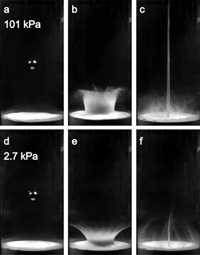|
||
      |
Citations
The sea squirt and the tumor
Sea squirts are poisonous to tumors, and now scientists know why. In the
December Nature Chemical Biology, Chicago chemists Sergey
Kozmin, PhD’98, and Alexander Statsuk,
along with researchers from Stanford and the National Institutes of Health,
unraveled the toxic effects of bistramide A, a metabolism by-product of
sea-squirts—sessile, invertebrate marine animals—that keeps
cancer cells from multiplying. According to the report, bistramide A binds
itself to the actin-polymer bundles that provide the mechanical force to
pinch cells apart during cytokinesis, thereby thwarting the final stage
of cell division. The researchers argue that bistramide A could offer a
potent biochemical tool for treating cancer.

Video images of a jet at normal pressure (top) and in a vacuum.
Jet propulsion
It seems there are at least four states of matter: liquid, solid, gas, and
a dense, fluid-like phase created by dropping a marble into a room-temperature
container of loosely packed sand. In the December Nature Physics,
University physicist Heinrich Jaeger and his
team describe the phenomenon, in which the falling marble’s impact
produces a jet of sand grains that briefly behaves like a dense fluid, with
little random interior motion. Conducting experiments both at normal air
pressure and in a vacuum, Jaeger found that air compressed between the sand
grains provided the energy that propelled the jet.
Neurological semaphore
Offering the first experimental evidence for a decades-old theory about
brain development, Chicago neurobiologist Yimin Zou
uncovered the mechanism nerve cells use to establish connections that relay
spatial information correctly from the eye to the brain. According to Zou’s
results, published in the January 5 Nature, two signaling systems
counterbalance to guide ”topographic mapping,” a process in
which the spatial order of neurons in one part of the nervous system gets
copied onto another, creating a controlled pattern of connections to transfer
information.
Counterintuitive multitasking
Why do people stop for ice cream on the way home from the gym? Or splurge
on luxurious vacations when they’re trying to save for retirement?
Graduate School of Business professor Ayelet Fishbach
says it’s because everyone pursues multiple simultaneous goals,
and progress toward one frees a consumer to follow an unrelated—or
even incompatible—aim. In their experiments, Fishbach and fellow researchers
found that 85 percent of dieters chose chocolate bars over apples when convinced
they were approaching their desired weights. Undergraduates made to believe
they were relatively devoted to schoolwork, meanwhile, became increasingly
interested in socializing. The results, published in the December Journal
of Consumer Research, show that simply planning to work toward one
goal can liberate a person to satisfy a conflicting desire.
Classroom connection
Distant, disconnected teachers may hamper ordinary high-schoolers, but they
pose a downright health hazard for delinquent teens, says Dexter
Voisin, a School of Social Service Administration researcher. Voisin
interviewed 550 teens at eight Georgia juvenile detention centers and found
that 14- to 18-year-olds reporting low “teacher connectedness”
were twice as likely to use marijuana and amphetamines. They were also twice
as likely to be sexually active, to have sex while intoxicated, to have
a partner who was intoxicated during sex, and to have multiple sexual partners.
Describing closeness with at least one caring teacher or coach as “critical,”
Voisin published his findings in the October Journal of Adolescent Health.